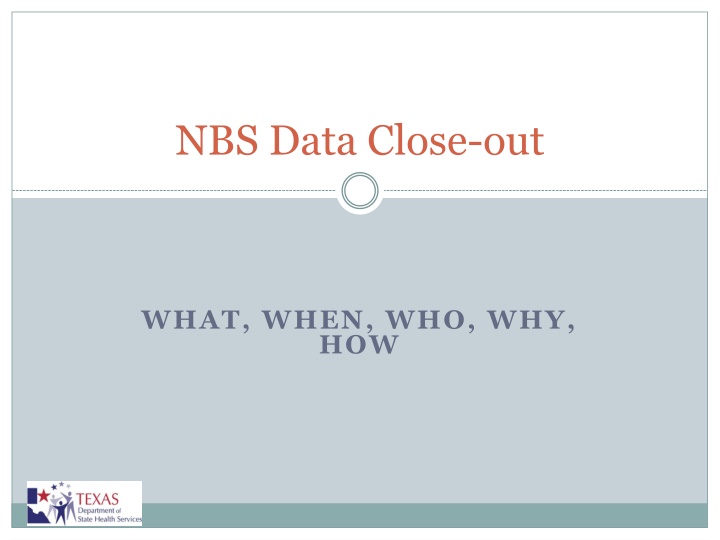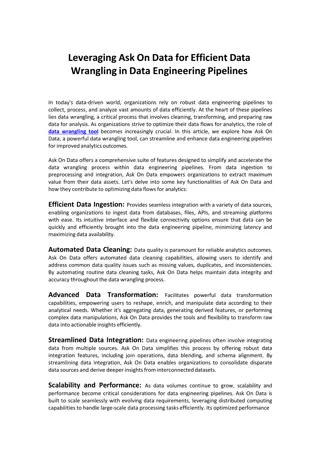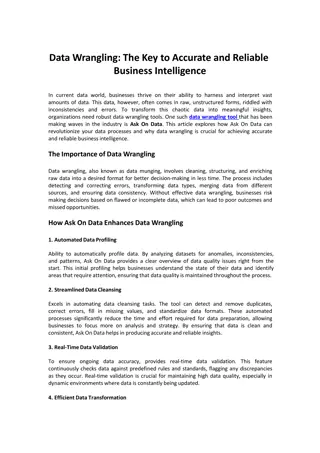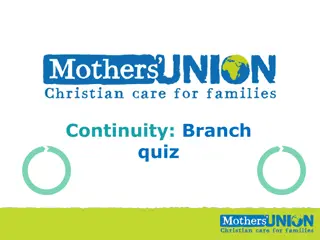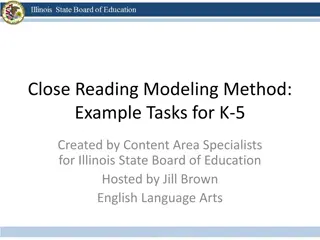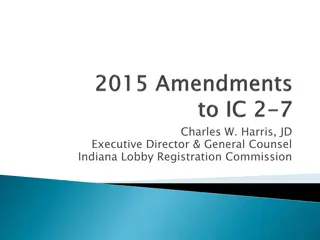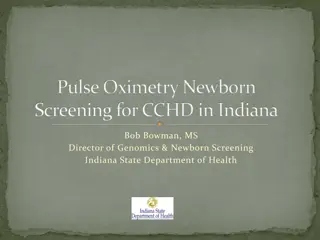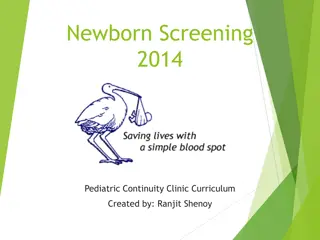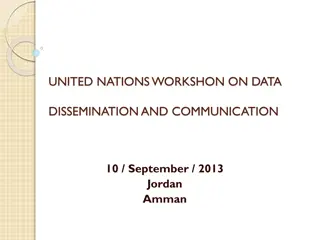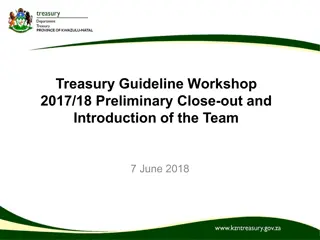NBS Data Close-out
This document outlines the NBS data close-out process including quality assurance timelines, official records finalization, data set closure goals, and the QA process to identify and resolve data aberrations. It details the timeline, responsibilities, and steps involved in ensuring accurate and complete data for public health publications. Key focus areas include finalizing case statuses, reconciling data with CDC, and ensuring clean data sets without missing core information or duplicate records.
Download Presentation

Please find below an Image/Link to download the presentation.
The content on the website is provided AS IS for your information and personal use only. It may not be sold, licensed, or shared on other websites without obtaining consent from the author.If you encounter any issues during the download, it is possible that the publisher has removed the file from their server.
You are allowed to download the files provided on this website for personal or commercial use, subject to the condition that they are used lawfully. All files are the property of their respective owners.
The content on the website is provided AS IS for your information and personal use only. It may not be sold, licensed, or shared on other websites without obtaining consent from the author.
E N D
Presentation Transcript
NBS Data Close-out WHAT, WHEN, WHO, WHY, HOW
Data Closure Final data sent to CDC in May Records become the official counts Same records are used for DSHS publications
Quality Assurance (QA) Timeline February Cut-off for entering new patients in NBS March QA by LHD\RHD staff edit records as needed based on QA findings Create investigations from lab data Change status of cases to final status (Confirmed, Probable, or Not a Case with a few exceptions) Reassign cases to correct MMWR year as needed Create notifications on completed cases as appropriate Case counts will be in flux April QA by Central Office edit records as needed based on QA findings RHD/LHD staff respond to issues identified
Official Records Final case status as defined by Epi Case Criteria Guide for corresponding year Notification approved MMWR year identifies calendar year of occurrence After data set is closed DO NOT edit above attributes for any record for that year For RHD/LHD do not edit case status or MMWR Year for 2012 records after 3/31/13 without consulting with Central Office staff No one should edit these after final data set uploaded by CDC
QA Timeline 5/1/13-5/xx/13 Reconcile data with CDC 5/xx/13 Data set is closed No edits to key data (Case Status, MMWR Year, Notification) Some updates permissible (e.g., serotype result, date of death) June State epidemiologist signs off on CDC data tables Data is now final and does not need to be labeled as preliminary in correspondence and publications.
Data Closeout Goal Data set is clean when the year is closed Data queries will not be missing core data (e.g., sex, age, county) No duplicate records Conditions correctly assigned General rule at this point is to let errors stand For conditions with low numbers, if a change is authorized the variance from official counts should be noted in publications
QA Process Identify and resolve aberrations in data Easier to recognize errors in data set than individual records Oversights can easily occur during data entry or notification approval but will show up in the data review QA process will identify records with most common errors Additional QA may be required to assure all cases are entered and condition is correctly assigned Laboratory report data in NBS and from other sources
QA Goals All 2012 records have been processed off of all of the queues on the NBS home page All 2012 cases are entered and are identified as 2012 by MMWR Year and Event Date All 2012 records have a final Case Status ( C , P , N , or, if defined as a final status, S ) that meets the case definition for that classification All records with Case Status of C or P (or S for CJD) have a notification that has been approved (Texas reportable conditions only) Each record has a date of birth (Birth Time) or age (Age Reported) that is reasonable for the condition Each record has sex assigned (Current Sex Code= F , M , or U -preferably F or M ) As many records as possible have race (Concatenated Race Description) and ethnicity (Ethnic Group) Each record has a County and it is consistent with address and jurisdiction There are no duplicate cases in the data set of approved confirmed and probable cases All investigations of approved confirmed and probable cases are closed (Investigation Status Code is C )
Laboratory Data Identify lab reports that should be cases and are not attached to investigations NBS system deleted from queue due to age or rule report filtered for Case Review Status = Processed and Last Changed User Name = Elrload, Nedss Selected conditions manual process of filtering Other data sources Join lab data and investigation case data: Assist in assigning case to correct MMWR year Identify cases mismatched with laboratory result
Missing Demographics Name Required for all cases unless person is unresponsive and unknown; then use description that makes it clear such as Homeless, Adult. Code name can be captured in demographics as name type Coded Pseudo . If unnamed newborn, last name of mother and first name of baby boy or baby girl is acceptable County Required for all cases. If patient location can not be found, then, select the county of the hospital or clinic where the patient was seen if it is available; if not, use the county of the reporting facility or the jurisdiction of the investigation, whichever is most appropriate. City and Address Fill in if known or type in Unknown . Zip If city and/or address is unknown zip code may be blank. If there is an address look up the zip code! Date of birth Fill in if possible. If unknown, leave blank and note reason in comments. Enter age in the age at onset field if known. Sex, Race and Ethnicity Fill in if possible. If unknown, select Unknown . Deceased Date Fill date of death in if Did the patient die from this illness?: is Y
Missing Dates Date of Report Use earliest date reported. Earliest Date Reported to State and/or County One or both should be filled in and earliest should match Date of Report. Investigation Start Date Must fill in. If no follow up was done, enter the date the report was received. Illness Onset Date Enter if known. If unknown, leave blank and enter diagnosis date. Diagnosis Date Must fill in if Illness Onset Date is unknown. Earliest date suspected Must fill in. Inconsistent dates Watch for dates that don t fit.
Earliest Date Suspected Date that a condition should be reported by a health professional Best resource date will vary by condition Purpose of field is to measure effectiveness of reporting NBS Data Entry Guide has condition-specific guidance Use available information and judgment along with guide Example specimen collection date appropriate for measles but not Salmonella
2012 Data Snapshot 2/21/13 Data from NBS Public Report QA Data Filters for reportable conditions Some additional conditions to assure reportables are captured Encephalitis, post-chicken pox and post-mumps Strep, other, invasive, beta-hem (non-A non-B) and Streptococcal toxic-shock syndrome Filters for all case statuses except Not a Case Filters for 2012 and 2013 cases Review of 2013 to reclassify as 2012 as needed
Scope of Task 20,972 records reviewed 20,038 with MMWR = 2012 (19,567) or MMWR Year = 2013 (471) and either Event Date in 2012 (46) or Event Date Type not based on onset date (425) 719 records with with one or more data issues (3.7%) 673 of the 19,567 MMWR Yr = 2012 (3.4%) 46 of the 471 MMWR Yr = 2013 (10%)
Event Date and MMWR Year Comparison MMWR Year = 2012 Event Date < 2012 1 4 0 3 0 0 0 1 9 MMWR Year = 2013 Event Date = 2012 0 16 8 8 6 1 0 5 44 Event Date > 2012 0 5 4 5 1 1 0 1 17 Event Date > 2012 Event Date Onset Region 1 2/3 4/5N 6/5S 7 8 9/10 11 Total 5 139 5 43 127 35 25 46 425* Sort on MMWR Year and Event Date. Filter by MMWR Year and review Event Dates. *Join to lab data and calculate minimum date among relevant dates to review.
Case Status Not Final MMWR Year = 2012 Case Status Region Suspect Unknown Blank 1 2/3 4/5N 6/5S 7 8 9/10 0 3 1 5 1 0 5 0 0 0 0 0 1 0 0 50 10 24 4 5 3 11 1 0 1 Total 16 1 97 *Suspect may be the final status for CJD, HCV infants, and Lyme and are not included in these counts
Notification Not Created MMWR Year = 2012 Case Status Region 1 2/3 4/5N 6/5S 7 8 9/10 11 Confirmed Probable Suspect Unknown 7 1 2 0 17 3 54 4 23 1 6 0 9 6 118 15 Blank 47 1 0 3 0 0 4 0 8 0 0 0 0 1 0 0 1 8 24 4 4 3 1 91 Total 127 16 10 1 94 Sort - First Notification Date; Filter = blank
Notifications Pending Approval MMWR Year = 2012 Program Area Pending Notifications Hepatitis 66 Foodborne 63 Hepatitis C 7 IDEAS 3 Immunizations 7 Respiratory/Meningitis 10 Waterborne 52 Zoonosis 35 Total 243 Filter - First Notification Date not blank; First Notification Sent Date = blank
Missing Demographic Data MMWR Year = 2012 Region Birth Date Sex Race Ethnicity 1 0 0 0 0 2/3 3 3 5 9 4/5N 0 3 1 3 6/5S 2 3 67 99 7 3* 12 5 3 8 1 5 1 1 9/10 0 1 3 0 11 0 1 0 1 Total 9 28 82 116 * 2 have age
Race with Unknown Race MMWR Year = 2012 Race Unknown & Black or African American Unknown & Asian Unknown & White Region 1 2/3 4/5N 6/5S 7 8 9/10 11 Total 0 1 1 4 1 2 0 0 9 0 2 0 4 0 1 0 1 8 0 25 6 42 12 32 3 17 137
Date of Birth = Event Date MMWR Year = 2012 Region Condition Aseptic (viral) meningitis Bacterial and other meningitis Campylobacteriosis Group B Streptococcus, invasive Hepatitis C, acute Pertussis Salmonellosis Streptococcus pneumoniae, invasive 1 0 0 0 5 0 0 0 1 2/3 4/5N 6/5S 7 2 1 0 0 1 0 13 4 0 0 0 0 1 0 1 1 8 11 9/10 0 0 0 12 0 1 1 0 0 0 0 1 1 0 4 0 0 0 0 0 0 0 9 0 0 0 0 0 1 0 3 1 0 1 0 10 0 1 2 0 Review as needed to validate; GBS in new born not uncommon
MMWR Year = 2012 Region County Blank 1 0 2/3 21 4/5N 8 6/5S 43 7 17 8 15 9/10 6 11 17 Total 127
Duplicate Investigations 63 pairs of duplicates with same patient ID number and similar event dates 4 are cross-jurisdictional and will be resolved during Central Office review 39 are Harris and/or Houston pairs involving recently uploaded data Additional reviews of pairs with same condition and event times needed (e.g., matching patient name and DOB, matching DOB and street) to find patients with different IDs, misspelled or reversed name, etc.
